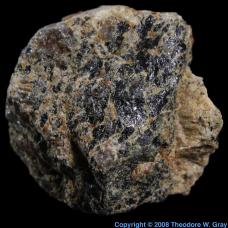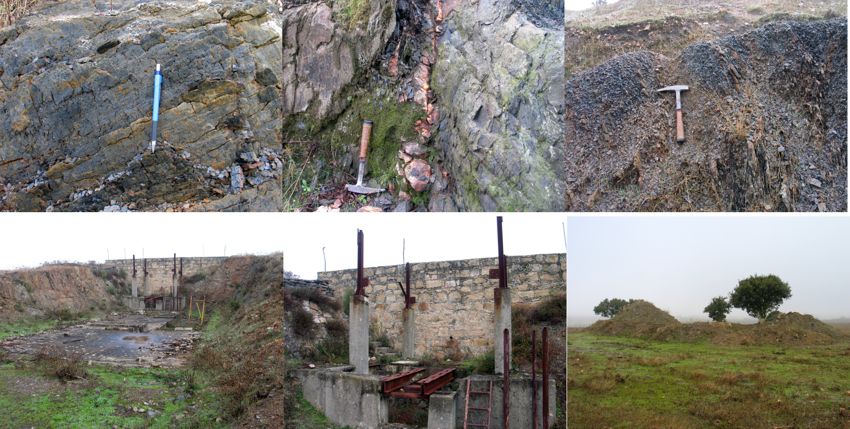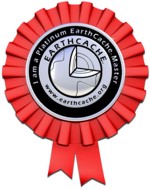From the guidelines, as from January 2013: "People do not need to wait for permission to log your EarthCache. Requiring someone to wait is not supported by the EarthCache guidelines. People should send their logging task answers to you, then log your EarthCache. When you review their logging task answers, if there is a problem, you should contact them to resolve it. If there is no problem, then their log simply stands."

U3O8
 Triuranium octaoxide (U3O8) is a compound of uranium. It is present as an olive green to black, odorless solid. In spite of its color, it is one of the more popular forms of yellowcake and is shipped between mills and refineries in this form.
Triuranium octaoxide (U3O8) is a compound of uranium. It is present as an olive green to black, odorless solid. In spite of its color, it is one of the more popular forms of yellowcake and is shipped between mills and refineries in this form.
 Triuranium octoxide occurs naturally as the olive-green-colored mineral pitchblende. U3O8 is readily produced from UF6 and has potential long-term stability in a geologic environment. In the presence of oxygen (O2), uranium dioxide (UO2) is oxidized to U3O8, whereas uranium trioxide (UO3) loses oxygen at temperatures above 500°C and is reduced to U3O8. The compound can be produced by any one of three primary chemical conversion processes, involving either uranium tetrafluoride (UF4) or uranyl fluoride (UO2F2) as intermediates. It is generally considered to be the more attractive form for disposal purposes because, under normal environmental conditions, U3O8 is one of the most kinetically and thermodynamically stable forms of uranium and also because it is the form of uranium found in nature. Its particle density is 8.3 g cm−3. (Source: Here)
Triuranium octoxide occurs naturally as the olive-green-colored mineral pitchblende. U3O8 is readily produced from UF6 and has potential long-term stability in a geologic environment. In the presence of oxygen (O2), uranium dioxide (UO2) is oxidized to U3O8, whereas uranium trioxide (UO3) loses oxygen at temperatures above 500°C and is reduced to U3O8. The compound can be produced by any one of three primary chemical conversion processes, involving either uranium tetrafluoride (UF4) or uranyl fluoride (UO2F2) as intermediates. It is generally considered to be the more attractive form for disposal purposes because, under normal environmental conditions, U3O8 is one of the most kinetically and thermodynamically stable forms of uranium and also because it is the form of uranium found in nature. Its particle density is 8.3 g cm−3. (Source: Here)
Uranium
Discovery - The discovery of the element is credited to the German chemist Martin Heinrich Klaproth. While he was working in his experimental laboratory in Berlin in 1789, Klaproth was able to precipitate a yellow compound (likely sodium diuranate) by dissolving pitchblende in nitric acid and neutralizing the solution with sodium hydroxide.Klaproth assumed the yellow substance was the oxide of a yet-undiscovered element and heated it with charcoal to obtain a black powder, which he thought was the newly discovered metal itself (in fact, that powder was an oxide of uranium).He named the newly discovered element after the planet Uranus, which had been discovered eight years earlier by William Herschel (who had named the planet after the primordial Greek god of the sky). (Source: Here).
Applications - The major application of uranium in the military sector is in high-density penetrators. This ammunition consists of depleted uranium (DU) alloyed with 1–2% other elements. At high impact speed, the density, hardness, and pyrophoricity of the projectile enable destruction of heavily armored targets. Tank armor and other, removable vehicle armor are also hardened with depleted uranium plates. Depleted uranium is also used as a shielding material in some containers used to store and transport radioactive materials. While the metal itself is radioactive, its high density makes it more effective than lead in halting radiation from strong sources such as radium.
The main use of uranium in the civilian sector is to fuel nuclear power plants. One kilogram of uranium-235 can theoretically produce about 80 terajoules of energy (8×1013 joules), assuming complete fission; as much energy as 3000 tonnes of coal. (Source: Here).
Claiming a find in this EC:
At ground zero, face S (If you've used my waypoints it is simply straight ahead of you) and 1- count the number of benches (That is the number of "steps") of the open cast mine; 2- How wide are the benches; and 3- How high are they?. After you have worked out these answers, please log your find but send me, through my profile, the answers (*). If it is correct, you will not hear from me again but know that I truly appreciate you taking the time to visit this small uranium mine and I hope that you have learnt a little bit more about the geological processes that take place on the surface of the earth. If it's wrong I will send you an explanatory note showing you where you went wrong. If you don’t send the answer, your log will be deleted without any explanation.
(*) Please note that when you e-mail me, please supply the reference of the cache (GC2JPKC) and name (e.g. Triuranium octoxide (U3O8) - DP/EC-57) of the cache and please click on the “I want to send my e-mail address along with this message” so that when I reply to you the messages don’t go into e-mail heaven (or hell).

Nisa Uranium Mine
Introduction - Uranium reserves were discovered Nisa in 1959 and studied in detail in the following decades. TheNisa deposit is considered the largest in the country, and the resource is estimated that around 4100 tonnes of uranium. The mediareports that the Directorate General of Geology and Energy is preparing the specifications for the opening of an international contest aimed at eventual award of the concession for the exploitation of uranium reserves Nisa. The high price of uranium on the international market indicates the economic viability of the project and justifies the great interest shown by multinational companies and consortia that concession.
Geology - The Nisa deposit is located in the exocontact of the the Schist Greywacke Complex with the Nisa batholith immediately to the south. The rocks are contact metamorphosed metasediments of Cambrian age The Hercynian Nisa batholith is mainly of granodioritic and tonalitic composition with several vein-type uranium and zirconium occurrences. Some of the granitic facies are explored for dimension stone, eg. Alpalhão.
While no uranium minerals are now visible on the surface, unless you examine samples in thin-section, you nevertheless have a small open cast mine that amazingly produced uranium. The reworking of this mine is highly controversial and there is an active movement called MUNN (Movimento Urânio em Nisa Não) that strongly oppose any mining activity in this deposit fearing contamination of the population. (other links: x, x)


 U3O8
U3O8
U3O8 é um composto de urânio. Está presente com uma cor verde azeitona a preto mas apesar de sua cor, é uma das formas mais populares de yellowcake.
U3O8 ocorre naturalmente como o mineral pechblenda. U3O8 é facilmente produzido a partir de UF6 e possui estabilidade a longo prazo potencial em um ambiente geológico. Na presença de oxigénio (O2), dióxido de urânio (UO2) é oxidado a U3O8, enquanto que o trióxido de urânio (UO3) perde oxigénio a temperaturas acima de 500 ° C e é reduzida a U3O8. O composto pode ser produzido por qualquer um dos três principais processos de conversão química, envolvendo tanto tetrafluoreto de urânio (UF4) ou de fluoreto de uranilo (UO2F2) como intermediários. É geralmente considerada a forma mais atraente para fins de eliminação, pois, em condições ambientais normais, U3O8 é um dos mais cineticamente e termodinamicamente estáveis formas de urânio e também porque é a forma de urânio encontrado na natureza. Sua densidade de partículas é de 8,3 g cm-3. (Fonte: Aqui)
Urânio
Descoberta - A descoberta do elemento é creditada ao químico alemão Martin Heinrich Klaproth. Enquanto ele estava trabalhando em seu laboratório experimental em Berlim, em 1789, Klaproth foi capaz de precipitar um composto amarelo (provavelmente diuranato de sódio ) pechblenda dissolvendo em ácido nítrico e neutralizar a solução com hydróxido. Klaproth sódio assumiu a substância amarela foi o óxido de elementos ainda não descobertos e aquecida com carvão para a obtenção de um pó preto, que ele pensava que era o metal recém-descoberto em si (na verdade, que o pó era um óxido de urânio). Ele nomeou o novo elemento descoberto depois que o planeta Urano, que tinha foi descoberto oito anos antes por William Herschel (que tinha chamado o planeta após o deus grego primordial do céu). (Fonte: Aqui).
Aplicações - A principal aplicação do urânio no sector militar está em penetradores de alta densidade. Esta munição é composto de urânio empobrecido (DU) ligado com 1-2% de outros elementos. Na velocidade de alto impacto, a densidade, dureza, e piroforicidade do projétil permitir a destruição de alvos pesadamente blindados. Tanque de armaduras e outros veículos blindados removíveis são também endureceu com as placas de urânio empobrecido. O urânio empobrecido é usado também como um material de protecção em alguns recipientes usados para armazenamento e transporte de materiais radioactivos. Enquanto o metal em si é radioativo, sua alta densidade faz com que seja mais eficaz do que levar na radiação travar a partir de fontes fortes, como o rádio.
O principal uso do urânio no setor civil é o combustível para usinas nucleares. Um quilograma de urânio 235 pode, teoricamente, produzem cerca de 80 terajoules de energia (8 × 1013 joules), assumindo a cisão completa; tanta energia quanto 3.000 toneladas de carvão.
Jazigo de Nisa
As reservas de urânio de Nisa foram descobertas em 1959 e estudadas em pormenor nas décadas seguintes. O jazigo de Nisa é considerado o maior do país, e estima-se que aí existam 4100 toneladas de urânio. Na comunicação social tem sido noticiado que a Direcção Geral de Geologia e Energia está a elaborar o caderno de encargos com vista à abertura de um concurso internacional visando a eventual atribuição da concessão de exploração das reservas de urânio de Nisa. A elevada cotação do urânio no mercado internacional indicia a viabilidade económica do empreendimento e justifica o grande interesse manifestado por consórcios e empresas multinacionais nessa concessão.
Para logarem esta EC:
No ponto zero vira-te para sul e conta 1- o número de degraus que tem esta pequena mina; 2- Que largura têm os degraus e; 3- que altura têm estes mesmos degraus. Se achas que acertaste nas respostas faz o teu log mas envia-me as respostas para o meu mail com a identificação da cache (nome ou código GC) e quando o fizeres escolhe a opção “I want to send my e-mail address along with this message”. Obrigado.

 The most exciting way to learn about the Earth and its processes is to get into the outdoors and experience it first-hand. Visiting an Earthcache is a great outdoor activity the whole family can enjoy. An Earthcache is a special place that people can visit to learn about a unique geoscience feature or aspect of our Earth. Earthcaches include a set of educational notes and the details about where to find the location (latitude and longitude). Visitors to Earthcaches can see how our planet has been shaped by geological processes, how we manage the resources and how scientists gather evidence to learn about the Earth. To find out more click HERE.
The most exciting way to learn about the Earth and its processes is to get into the outdoors and experience it first-hand. Visiting an Earthcache is a great outdoor activity the whole family can enjoy. An Earthcache is a special place that people can visit to learn about a unique geoscience feature or aspect of our Earth. Earthcaches include a set of educational notes and the details about where to find the location (latitude and longitude). Visitors to Earthcaches can see how our planet has been shaped by geological processes, how we manage the resources and how scientists gather evidence to learn about the Earth. To find out more click HERE.